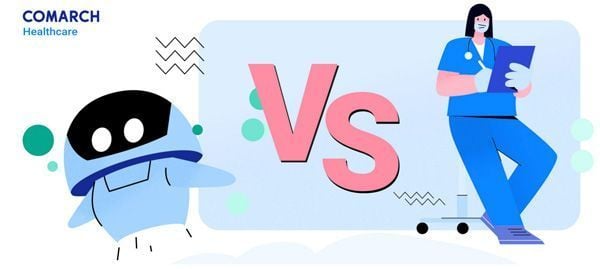HealthManagement, Volume 21 - Issue 8, 2021
An overview of the role of Artificial Intelligence during the treatment process and implementation of AI algorithms to increase patient awareness and improve access to anonymised data.
Artificial intelligence has been pushing itself into the digital space of the medical industry for several years. Recently, however, this process has accelerated significantly. Newer and more effective diagnostic algorithms are emerging, but what is equally important is that their real use in medicine is increasing. More and more relatively simple, time-consuming tasks, so disliked by doctors, are being replaced by algorithms. Medical staff are beginning to notice that artificial intelligence is not there to replace doctors, but to help them in their work. This difference in perception and rejection of fears makes doctors understand the enormous advantages of artificial intelligence, however imperfect it may still be (Songhee et al. 2019).
Analysis of 720 Hours of Examination in Seconds
A great example of artificial intelligence algorithms supporting medical personnel can be any kind of long-term testing or screening. In both cases, it is necessary to analyse a lot of data. Comarch offers cardiac telemonitoring services, which analyse and detect silent atrial fibrillation in a 30-day ECG examination. This episodic disorder is very difficult or even impossible to detect with an ordinary 24-hour holter, since it occurs relatively rarely, without noticeable symptoms (Barbarossa et al. 2014). Performing such a long study would not be possible without AI algorithms. Reviewing 720 hours of signals by a medic or technician would be a great effort, and that’s just for one patient. Artificial intelligence algorithms first filter out unnecessary fragments of the signal (the correct signal or interference). After all, the doctor does not have to look at these. The doctor is presented with only parts in which the AI has noticed a high degree of probability of disorders occurring. The browser gives you the opportunity to quickly mark the selected fragments as true or false detection, and after completing the entire 30-day examination, these data are presented in a friendly report for the patient. This is a perfect example of how AI improves medical analysis. Without automation, such a study would be almost impossible or extremely expensive, which would translate into its limited availability.
AI in Imaging Diagnostics
Another example can be all kinds of algorithms to support diagnosis in imaging tests. Quick identification of suspicious fragments allows a doctor to save invaluable time, make decisions and implement treatment. Detection of cancer lesions from MRI, CT or mammography images are just a few examples of the use of artificial intelligence in the fight against cancers (Oren et al. 2020) and other diseases. Recently, however, the global pandemic has expanded the scope of AI use in imaging research. Algorithms, based on x-rays, CT or MRI of the chest, are able to very quickly assess the degree of lung damage or carry out triage of patients (DeGrave et al. 2021).
Application Instead of a Binder With Medical Records
Equally important from the point of view of fast and accurate diagnostics is the management of your own medical records. Having full documentation always where you need it allows you to share selected elements of it with doctors. However, it is very often that patients get documents in paper form, as a result of which they come to the doctor with a large binder. This is where the Comarch MojeZdrowie24 application comes in handy, allowing, for instance, storage and management of results of medical checks. We store documents in the form of photos, and adding more files is extremely simple. But what if a great many of these documents are collected? This is where AI algorithms that can determine the type of document and indicate the keywords that will come in handy. This makes searching our digital medical records extremely easy.
Algorithms, based on x-rays, CT or MRI of the chest, are able to very quickly assess the degree of lung damage or carry out triage of patients
Digital Twins Instead of a Control Group
An extremely interesting direction of development of AI in medicine is the creation of “digital twins”, used as a control group at the stage of clinical trials or to predict the progression of a given disease (for example, Alzheimer’s) (Kesari 2021). These are models that describe the current and future state of health of patients, such as predicted reactions to a drug or the progression of a disease (Fisher 2019). This solution would significantly speed up and reduce the cost of human testing during the implementation of new drugs. Of course, technology will not completely replace this important stage of drug development, but it will allow you to better prepare for it and can reduce the costs and time spent on recruiting a control group.
These are just a few examples of how artificial intelligence supports the treatment process - from the creation of drugs to diagnosis, management of medical records, and supervision of the treatment of patients. From year to year, more and more such systems appear. However, the key problem when creating these solutions is data. Currently, legal regulations do not allow easy access to medical data. However, I believe that the benefits of implementing AI algorithms in medicine will increase patient awareness and allow easier access to anonymised data, which as a result will allow more dynamic growth of AI-assisted services.

Disclosure of conflict of interest: Point-of-View articles are the sole opinion of the author(s) and they are part of the HealthManagement.org Corporate Engagement or Educational Community Programme.
References:
Barbarossa A, Guerra F, Capucci A (2014) Silent Atrial Fibrillation: A Critical Review. J Atr Fibrillation, 7(3):1138.
DeGrave AJ, Janizek JD, Lee SI (2021) AI for radiographic COVID-19 detection selects shortcuts over signal. Nat Mach Intell 3, 610–619
Fisher C (2019) Creating Digital Twin Controls for Alzheimer’s Disease Using Machine Learning. Unlearn.AI.Inc.
Kesari G (2021) Meet Your Digital Twin: The Coming Revolution In Drug Develoment. Forbes.
Available from https://www.forbes.com/sites/ganeskesari/2021/09/29meet-your-digital-twin-the-coming-revolution-in-drug-development/?sh=390eb29745fb
Oh S, Kim JH, Choi SW et al. (2019) Physician Confidence in Artificial Intelligence: An Online Mobile Survey. J Med Internet Res, 21(3):e12422.
Oren O, Gersh B, Bhatt D (2020) Artificial intelligence in medical imaging: switching from radiographic pathological data to clinically meaningful endpoints. The Lancet Digital Health. 2. e486-e488.







